Contributory members are able to log private notes and comments about each site
Sites theCaptain has logged. View this log as a table or view the most recent logs from everyone
Petite Roche allée couverte
Trip No.201 Entry No.7 Date Added: 25th Mar 2020
Site Type: Passage Grave
Country: France (Normandie:Manche (50))
Visited: Yes on 22nd Nov 2004. My rating: Condition 3 Ambience 4 Access 5
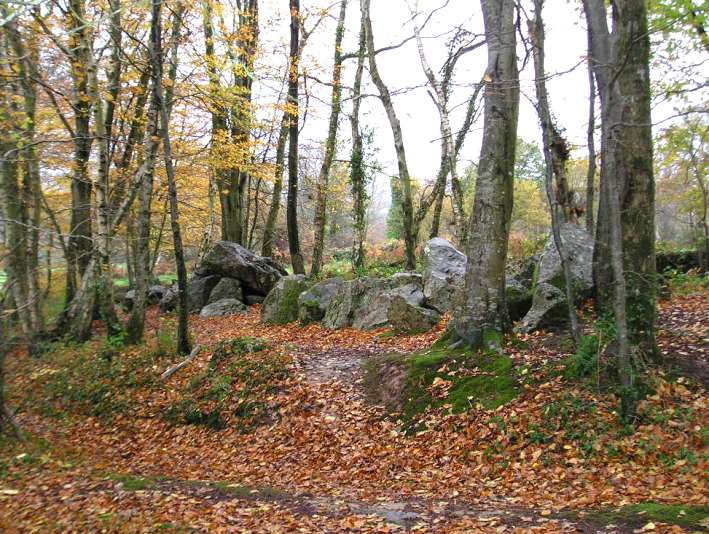
Petite Roche allée couverte submitted by thecaptain on 27th Dec 2004. Allée Couverte de la Petite Roche, Rocheville, Normandie.
Most of the remains are seen here in this view from the southeast.
(View photo, vote or add a comment)
Log Text: In the woods around the village of Rocheville can be found the remains of three Allées Couverte, only one of which is marked on the IGN maps, which is known as the Allée Couverte de la Petite Roche. To the southeast of Rocheville is a wooded area known as Bois de la Grosse Roche, and in the southwest corner of this wood, almost right beside the lane, is found the Allée Couverte de la Petite Roche.
About 20 metres in length, it runs in an east west direction. The width between the stones, of which there would have been about 20 in each row, is between 1 and 1,5 metres, and the height is about the same. At the east end of the allée the end stone remains in place, while at the west end it is open, but with a large stone across the rows about 3 metres distant, possibly a removed roofstone. About 5 cover stones remain in position, in two groups, two near the east end, and the other three nearer to the west end. There are many other stones lying around in the wood, probably some parts of the monument.
Twyn-Yr-Oerfel A
Date Added: 22nd Mar 2020
Site Type: Round Barrow(s)
Country: Wales (Monmouthshire)
Visited: Yes on 21st Mar 2020. My rating: Condition 3 Ambience 3 Access 4
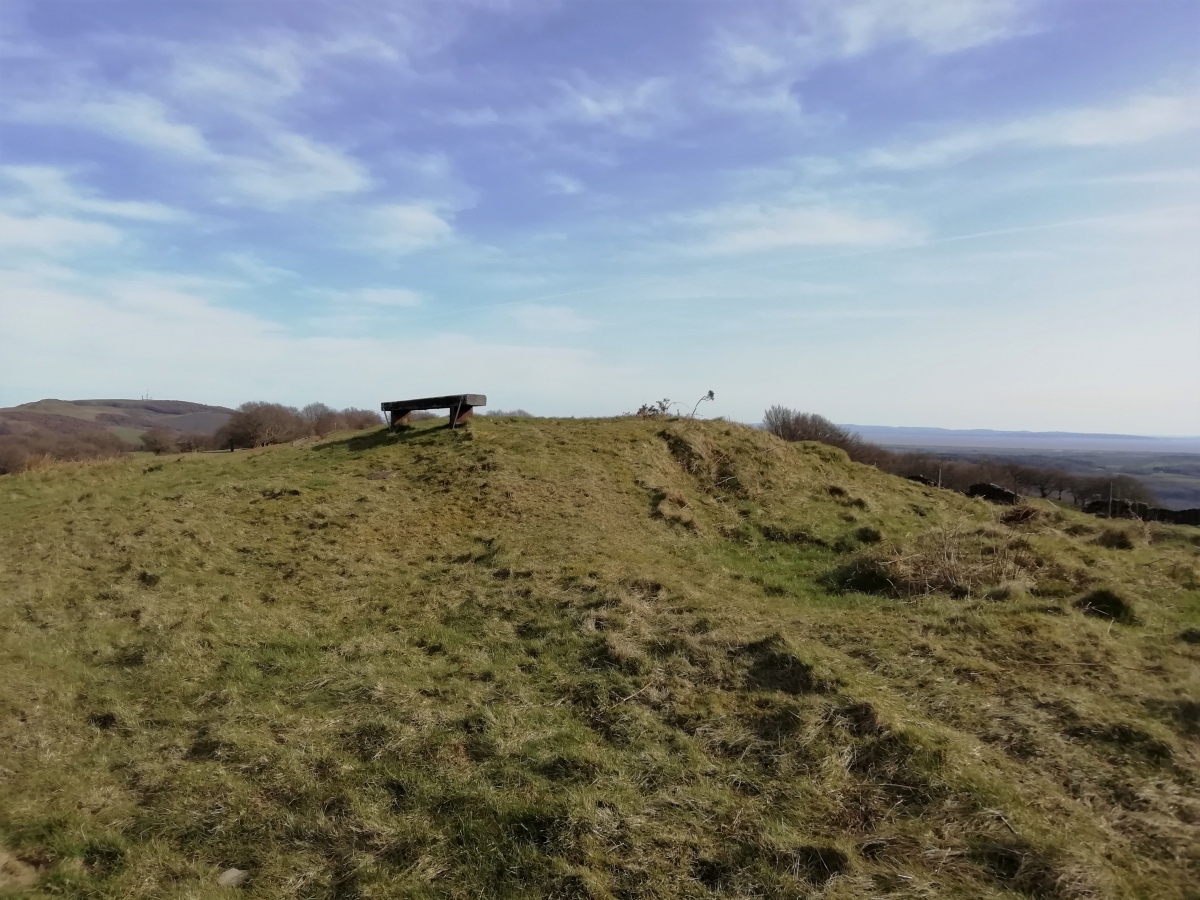
Twyn-Yr-Oerfel A submitted by TheCaptain on 25th Mar 2020. The easterly of the two barrows, this one is the more ruined, but easily found and identified. It has a large pit dug into the top and a bench positioned on the top.
The views from up here would be terriffic, but the whole area is not a great place to be with so many off road tracks all around making the whole area a mess of mud.
(View photo, vote or add a comment)
Log Text: The fourth and last cairn marked on the OS Map during a walk from the Sirhowy Country Park around the Cwmfelinfach valley, up the Sirhowy River and back along the Rhymney Ridgeway path.
A few hundred yards to the east of the previous barrow, this one is more ruined than that, but easily found and identified. It has a large pit dug into the top and a bench positioned on the top. The views from up here would be terriffic, but the whole area is not a great place to be with so many off road tracks all around making the whole area a mess of mud. The old mining tips don't help, so perhaps it is an improvement on a century ago.
Twyn-Yr-Oerfel B
Date Added: 22nd Mar 2020
Site Type: Round Barrow(s)
Country: Wales (Monmouthshire)
Visited: Yes on 21st Mar 2020. My rating: Condition 3 Ambience 3 Access 4
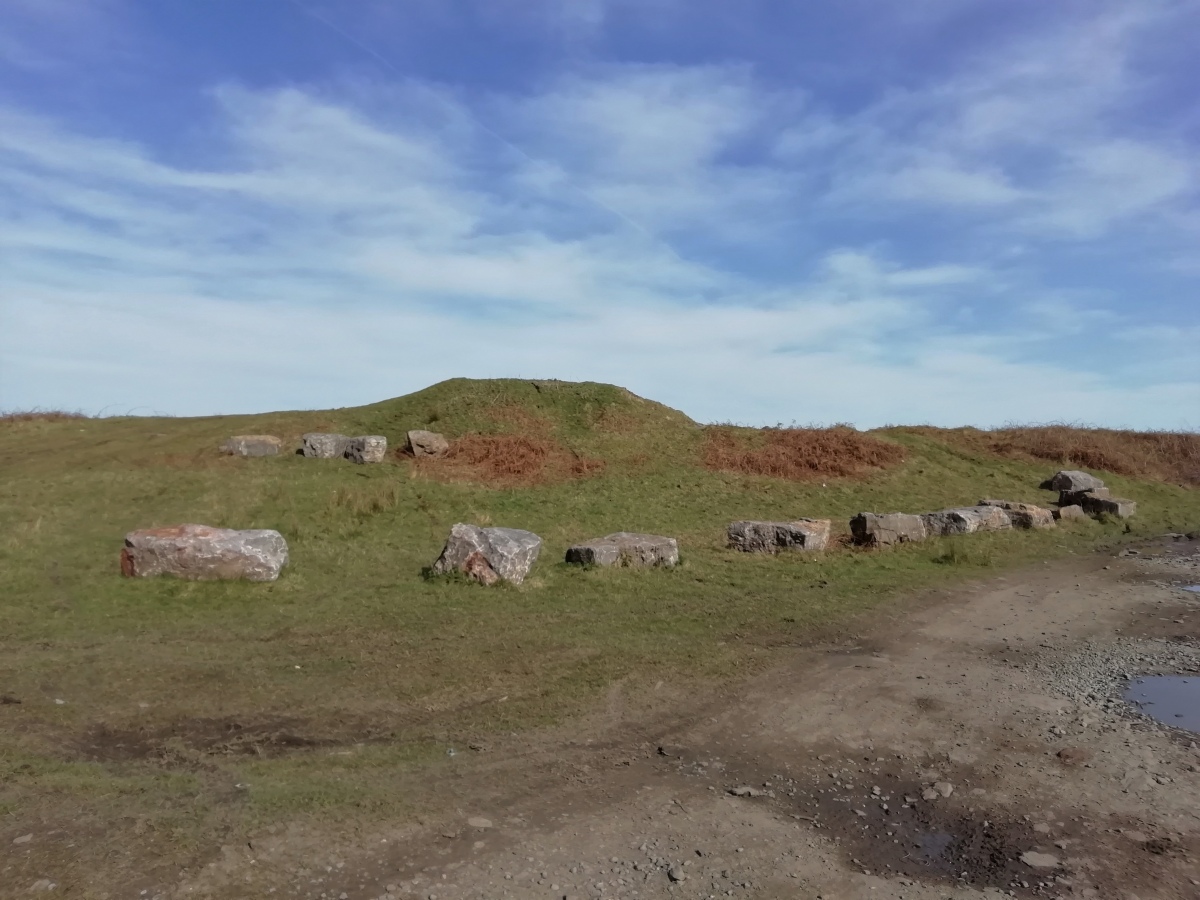
Twyn-Yr-Oerfel B submitted by TheCaptain on 29th Mar 2020. Following the ridgeway track to the south the barrow is right in front of you as you descend into the open land. It was surrounded by many large blocks of stone to prevent the off road drivers driving over it.
(View photo, vote or add a comment)
Log Text: The third cairn of four marked on the OS Map during a walk from the Sirhowy Country Park around the Cwmfelinfach valley, up the Sirhowy River and back along the Rhymney Ridgeway path.
Following the ridgeway track to the south and then east passing beween the large minimg tip and the forest along the stony track used by off road bikers, and the barrow is right in front of you as you descend into the open land. It was surrounded by many large blocks of stone to prevent the off road drivers driving over it, but this does not prevent the bikers.
While here there was the remains of a burnt out motorbike laying just beside it. The barrow is nicely formed apart from the tracks over it, and looked initially to have a large stone structure within, but I later read that it is built onto a natural rock outcrop, so this is probably part of it.
Twyn Cae-Hugh
Date Added: 22nd Mar 2020
Site Type: Round Barrow(s)
Country: Wales (Monmouthshire)
Visited: Yes on 21st Mar 2020. My rating: Condition 3 Ambience 3 Access 4
Twyn Cae-Hugh submitted by TheCaptain on 25th Mar 2020. This was an easily seen tumulus of fairly large size just to the east of the trackway
(View photo, vote or add a comment)
Log Text: The second cairn of four marked on the OS Map during a walk from the Sirhowy Country Park around the Cwmfelinfach valley, up the Sirhowy River and back along the Rhymney Ridgeway path.
This was an easily seen tumulus of fairly large size just to the east of the trackway and walled off from it, which has helped with its survival. We stopped here for lunch sheltered from the wind and in the sun.
Mynydd Bach Cairn 2
Date Added: 22nd Mar 2020
Site Type: Round Barrow(s)
Country: Wales (Monmouthshire)
Visited: Yes on 21st Mar 2020. My rating: Condition 2 Ambience 2 Access 4
Mynydd Bach Cairn 2 submitted by TheCaptain on 25th Mar 2020. Found the remains of this cairn fairly easily, making a circular patch of green grass amongst the gorse and other growth. It is not a great monument being very flattened and destroyed, and also the whole area is absolutely covered with rubbish of all sorts.
(View photo, vote or add a comment)
Log Text: First cairn of four marked on the OS Map during a walk from the Sirhowy Country Park around the Cwmfelinfach valley, up the Sirhowy River and back along the Rhymney Ridgeway path. Found the remains of this cairn fairly easily, making a circular patch of green grass amongst the gorse and other growth. It is not a great monument being very flattened and destroyed, and also the whole area is absolutely covered with rubbish of all sorts. The whole area is used by people for offroading and all sorts of other activities, some not so wholesome.
Allée couverte du Bois de la Plesse (Sud)
Trip No.201 Entry No.3 Date Added: 19th Mar 2020
Site Type: Passage Grave
Country: France (Normandie:Manche (50))
Visited: Yes on 19th Nov 2004. My rating: Condition 3 Ambience 3 Access 4
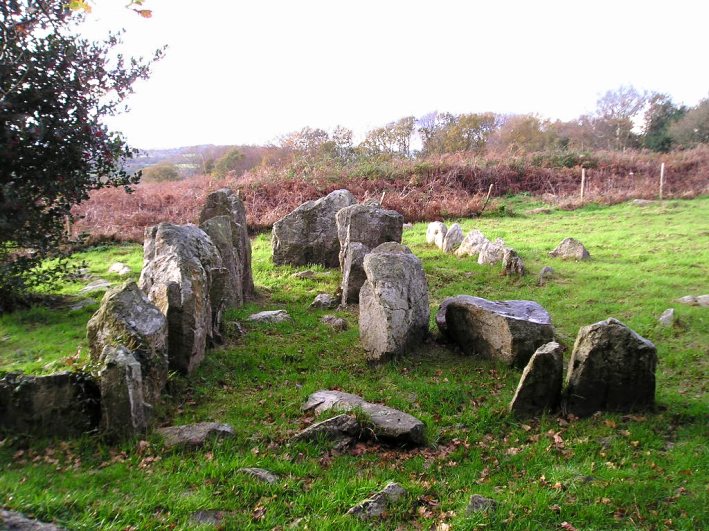
Allée couverte du Bois de la Plesse (Sud) submitted by thecaptain on 3rd Jan 2005. Allée Couverte du Bois de la Plesse (South).
Looking approximately westwards into the main chamber of the southern tomb. Not only do the large stones of the central chamber survive, but also many of hte smaller stones which presumably once made up a kerb to the covering mound, and some sort of entrance facia.
(View photo, vote or add a comment)
Log Text: On the slopes of Mont Castré to the southwest of the village of Lithaire can be found a little leisure park surrounding a quarry with lake. From the car park, cross the lake and climb the steep path to the top of the quarry before following the path around the top to the right through the woods. After a few hundred metres you reach an open grassy area within which are the remains of two Allées Couverte, not marked on my IGN maps.
About 25 metres to the south of the northern site are the remains of the much better preserved southern Allée Couverte. Most of the side stones remain of a 7 metre long central chamber, including the western end stone, but there are none of the covering slabs. Surrounding this chamber are many smaller stones which were probably facing stones for the covering mound, which today form a couple of parallel rows to the sides of the main chamber. At the eastern side is a nice straight row of these stones running across at right angles to the main chamber, perhaps once forming some kind of entrance arrangement. There are many other stones laying around which probably once formed a part of this monument.
Allée couverte du Bois de la Plesse (Nord)
Trip No.201 Entry No.2 Date Added: 19th Mar 2020
Site Type: Passage Grave
Country: France (Normandie:Manche (50))
Visited: Yes on 19th Nov 2004. My rating: Condition 2 Ambience 3 Access 4

Allée couverte du Bois de la Plesse (Nord) submitted by thecaptain on 31st Dec 2004. Allée Couverte du Bois de la Plesse (north), near Lithaire in Manche, Normandie.
Looking north at the eastern end of the remains of the northern allée couverte.
(View photo, vote or add a comment)
Log Text: On the slopes of Mont Castré to the southwest of the village of Lithaire can be found a little leisure park surrounding a quarry with lake. From the car park, cross the lake and climb the steep path to the top of the quarry before following the path around the top to the right through the woods. After a few hundred metres you reach an open grassy area within which are the remains of two Allées Couverte, not marked on the IGN maps.
The first to be reached, northern, of these is in a very ruined state, with just some large stones of the central chamber remaining, and most of these are fallen. The length of the chamber can be traced for 9 metres, and some of the stones at the east end, including the eastern end stone, remain standing.
Dolmen du Bois de la Plesse
Trip No.201 Entry No.4 Date Added: 19th Mar 2020
Site Type: Burial Chamber or Dolmen
Country: France (Normandie:Manche (50))
Visited: Yes on 19th Nov 2004
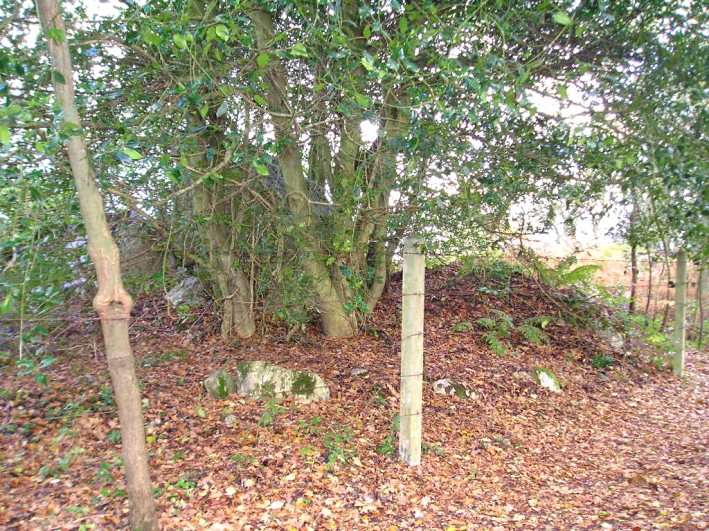
Dolmen du Bois de la Plesse submitted by thecaptain on 3rd Jan 2005. Bois de la Plesse (possible dolmen).
While walking along the path round the top of the quarry, my eye was caught by an arrangement of large boulders piled on top of each other on a small mound. Having a closer look, I suspect that the large boulders hidden by the tree owe more to their current position due to relatively modern quarrying than anything ancient, but the mound on which they lie is most interestingly surrounded by what look like very old, carefully placed kerbing stones which can ...
(View photo, vote or add a comment)
Log Text: On the slopes of Mont Castré to the southwest of the village of Lithaire can be found a little leisure park surrounding a quarry with lake. From the car park, cross the lake and climb the steep path to the top of the quarry before following the path around the top to the right through the woods. The monuments are said to have only been discovered in 1965, and with all the other stones laying around in the woods and undergrowth in this area, it wouldn’t surprise me if much more remains to be discovered here. In fact, while walking along the path round the top of the quarry, my eye was caught by an arrangement of large boulders piled on top of each other on a small mound. Having a closer look, I suspect that the large boulders owe more to their current position to relatively modern quarrying than anything ancient, but the mound on which they lie is most interestingly surrounded by what look like very old, carefully placed kerbing stones. I wouldn’t be at all surprised if this is the remains of another Dolmen of some kind.
The coordinates on my GPS (which was slightly misbehaving with low battery power) for this were N 49.28388, W 001.49166 should anyone want a look. Further to the east on Mont Castré are the remains of a Roman encampment, while a bit to the west is a ruined castle, which go to demonstrate the importance of this hill as a place of settlement right through history.
On a further visit here I was not so sure that this was an ancient dolmen this time round, although the circular surrounding stones were still looking like something not natural Perhaps thing as a result of quarrying?
Tumulus de Vierville
Trip No.201 Entry No.1 Date Added: 19th Mar 2020
Site Type: Chambered Tomb
Country: France (Normandie:Manche (50))
Visited: Yes on 19th Nov 2004. My rating: Access 1
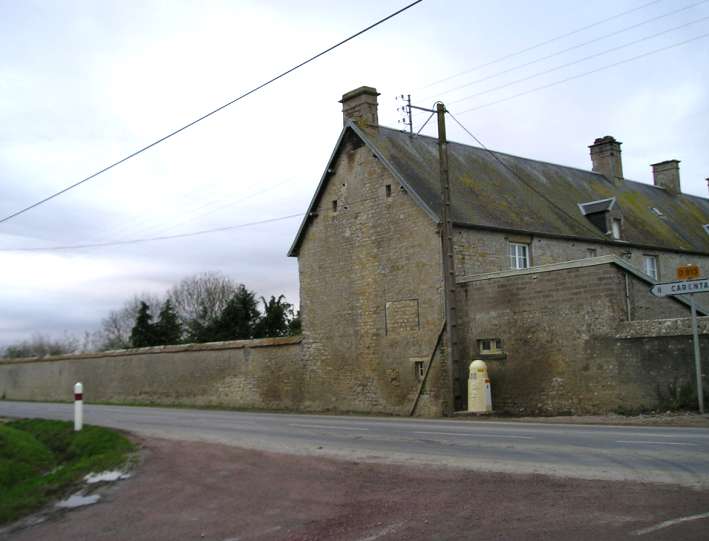
Tumulus de Vierville submitted by thecaptain on 14th Jan 2005. Tumulus de la Butte, Vierville, Manche.
Despite much research, and two visits to this site, I could find no traces of this supposedly wonderful monument, marked on many maps as a notable attraction. My research leads me to believe it is somewhere within this walled garden.
(View photo, vote or add a comment)
Log Text: Try as I might, early in the morning on the way to my sisters from the ferry, by driving up and down every lane and farm track around the village, I couldn’t find any sign of this, despite it being highlighted as a tourist place on the IGN maps. I asked a chap passing on his way to work on a bike if he knew anything of it with no luck, and also an old couple herding cows from one field to another, who said they had lived there all their lives but had also never heard of it. They seemed very intrigued as to what an Englishman was doing in their village asking for a monument and pointing at something on a map. It must have made their day, but it didn’t help me in any way.
After taking a last guess and driving half a mile up a muddy track to the top of a nearby hill, and walking round all the woodland on the top, all I could find was a couple of interested donkeys. An hour had now gone by, and it was time to get on. Not much of a tourist attraction ! Further investigation using more detailed local maps showed the tumulus positioned right opposite the road junction by the church. If accurate, this meant that the tumulus was either in the garden of a large house, or in a nearby farmyard.
Passing near by the site on the way back to the ferry, I stopped off for another look round, this time knowing where to look. There was absolutely no sign of anything to be seen in any farmyards unless it has been covered with either a barn or a dungheap. This left the only place for it to be as in the walled in garden of the large house pictured, which had absolutely no places to look through. I could find nobody around to ask, and didn’t want to just go and call at a perhaps random private house, so had to give up again. It wouldn’t surprise me if it is positioned somewhere under the trees to be seen in the walled garden.
Once home, lots of painstaking research on the internet has revealed nothing more than that it is on private land. Its gotta be in that walled garden. Or is it ?
Cromeleque da Portela de Mogos
Date Added: 13th Nov 2019
Site Type: Stone Circle
Country: Portugal (Évora)
Visited: Yes on 13th Oct 2019. My rating: Condition 4 Ambience 5 Access 4

Cromeleque da Portela de Mogos submitted by Bak_teria on 7th Apr 2015. Hidden below the shadows of the trees, this cromlech has got a magical vibe.
(View photo, vote or add a comment)
Log Text: I have time to look for one or two more sites, the Cromeleque da Portela de Mogos is not far off, and I now remember spending quite some time looking how to find this before the trip. Back to the road from Cromeleque de Vale Maria do Meio, and half a kilometre to the west it goes up over a wooded hill, and I find a place to park beside the road in a layby. The cromlech should be just away from the road on the south side up the hill. Indeed, there is a footpath which can be seen going off into the woodland from a sort of gap in the fence, which can be opened.
A hundred yards or so up into the woods and a large standing stone can be seen, and then the other stones can also be seen, forming a circular shape around the large one with arms going down the slope. Again it is very like Almendres and Vale Maria do Meio, in that it seems to make an open horseshoe facing down the slope towards the east, although with a circle at the top. There are about 40 stones, and again many are beautifully shaped and have motifs carved onto them.
I am alone here in this lovely wooded place, and think that this is perhaps my favourite place of all my visits, so just linger for a fair while before leaving. After this, it feels wrong to search out any other lesser places, so decide to head back to Evora via the Alto de São Bento viewpoint and the aquaduct.
Alto de São Bento
Date Added: 11th Nov 2019
Site Type: Ancient Village or Settlement
Country: Portugal (Évora)
Visited: Yes on 13th Oct 2019. My rating: Condition 2 Ambience 5 Access 5

Alto de São Bento submitted by TheCaptain on 11th Nov 2019. Little remains to be seen of the prehistoric settlement which existed on this fine granite hilltop from 7000 years ago, which was the very origins of the fabulous and historic city of Évora.
Today this hilltop is topped with the remains of several windmills, and provides fantastic views over the city of Évora and all around the Alentejo region.
(View photo, vote or add a comment)
Log Text: Little remains to be seen of the prehistoric settlement which existed on this fine granite hilltop from 7000 years ago, which was the very origins of the fabulous and historic city of Évora. Today this hilltop is topped with the remains of several windmills, and provides fantastic views over the city of Évora and all around the Alentejo region. The views over Evora, particularly in this clear late afternoon light are fabulous, the low sun lighting up the large Evora buildings, town walls, the aquaduct and the nearby convent. While back in the other direction, the hilltop castle of Arraiolos can be seen.
Cromeleque de Vale Maria do Meio
Date Added: 8th Nov 2019
Site Type: Stone Circle
Country: Portugal (Évora)
Visited: Yes on 13th Oct 2019. My rating: Condition 4 Ambience 4 Access 5

Cromeleque de Vale Maria do Meio submitted by Ana on 20th Aug 2014. Site in Alentejo Portugal
(View photo, vote or add a comment)
Log Text: Despite the satnav taking me to the wrong place, using my phone I was able to determine how to get there, and it was then easily found and driven to along a dirt and gravel road, which interestingly had a little bridge seemingly built in the middle of nowhere which turned out to be a sort of tunnel for a huge herd of goats.
There were quite a few people at the cromlech, including half a dozen including girl in Blondie tee shirt who were taking many posed photographs of themselves, made me wonder whether they were a band doing a publicity shoot!
The site itself struck me as being rather like a smaller version of Almendres, a sort of open horseshoe shape of about 40 stones with the open end facing to the east down a gentle slope, while the biggest stones are at the upper western side, many of which had been nicely shaped.
Another beautiful place, and I learned afterwards that some of the stones have carvings.
While I was here, the local farmer drove out to the bridge thing and made noise, whereupon hundreds or even thousands of goats appeared, which he penned in before opening the gate under the bridge. The goats all then charged off towards where the farmer had come from in a mad rush, no doubt this was going to be their feeding time or such like.
Pawton Quoit
Date Added: 5th Nov 2019
Site Type: Burial Chamber or Dolmen
Country: England (Cornwall)
Visited: Yes on 20th Sep 2013. My rating: Condition 4 Ambience 3 Access 3
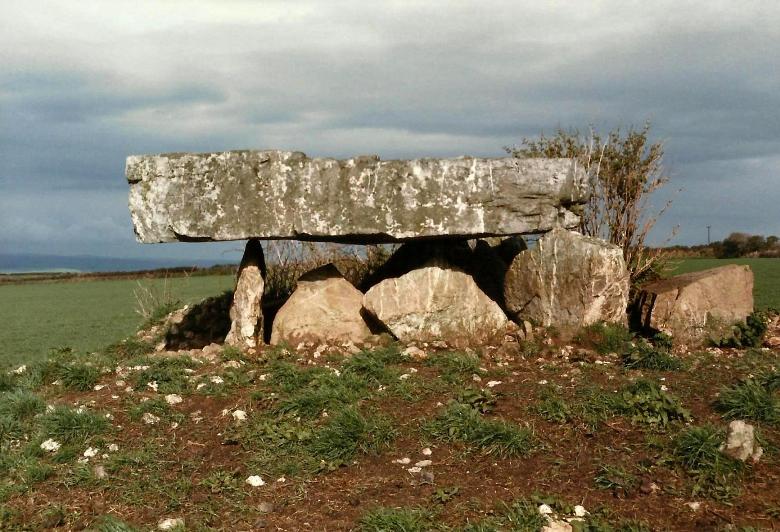
Pawton Quoit submitted by theCaptain on 23rd Mar 2014. Been sorting through some old photos, and heres one I found of Pawton Quoit back in 1986.
All nicely clear back then, unlike my visit last year (2013) when it was all totally overgrown.
(View photo, vote or add a comment)
Log Text: This really is a bit of a devil to get to, and it makes me wonder whether I really have been to it twice before, or just looked for it! I'm 99% sure I visited once in the 1970s with Mum and Dad, and then again in the 1980s, but perhaps not right to the stones that time. Taking the little lane southeast from the valley below Nanscow, the lane is signposted to some kennels, and after a short distance turns to the right and climbs uphill, getting narrower and more overgrown, but it is still easily driveable all the way up and over the hill to Haycrock farm (I dont know if it is private at this point). The trouble is there is almost nowhere to park or turn round, and no obvious place to get into the right field for the quoit. I ended up turning and then driving almost right back down to the bottom to park and then walk back up to a place where many people obviously climb over the wall to visit the quoit. Its a bit of a tricky wall to get over with a fair drop down into the field, so I told Dad not to come and stay outside the field till I returned. The field had no crop in it, so I decided I was OK for a visit to the dolmen, which could be seen as an overgrown mess several hundred yards across the field. When I got to it, it at first looked like there would be no way through to the stones, as the whole thing was surrounded by masses of gorse, brambles, ferns, stinging nettles etc, but around the far side there was a trampled down way in. The stones are all very angular and sharp cornered, and of a very pale stone. The capstone is a delight, perched above its chamber on several smaller stones, in some respects giving the impression of teeth below it! The capstone has broken, and about a third of it lies flat to the ground at one end, amongst a bit of a jumble of stone and a tree now happily growing in amongst it all. With all the jungle growing here, its difficult to make out what the arrangement really was, but it is a bit of a delight, and has some spectacular views to the north over the Camel Estuary and east to the heights of Bodmin Moor and Wadebridge down in the valley below. I never really felt at ease here, possibly because of leaving Dad and the car so far off, so after taking several photos from all angles, trudged back to the field wall where the way over was, only to find that Dad was no longer there. Where is he? whats he doing? I cant get out of this field without some help. Hmmm, still no sign of Dad, and he clearly can't hear me yelling, so need a plan B. Looking around, a bit further up along the wall, and there is a lower section with a tree nearby which I can use to hold and climb up onto the top, before making my way along to the gap and then down off the wall and onto the lane. Theres Dad way down the lane looking for blackberries and whacking things with a stick, oblivious to my plight! No doubt I had some sharp words on the walk back down to the car, before jokingly suggesting looking for the Nanscow inscribed stone, and then heading off to The Ring O'Bells at St Issey for a well deserved pint.
The Stones, Tresallyn Cross
Date Added: 5th Nov 2019
Site Type: Modern Stone Circle etc
Country: England (Cornwall)
Visited: Yes on 28th Sep 2012. My rating: Condition 4 Ambience 3 Access 5
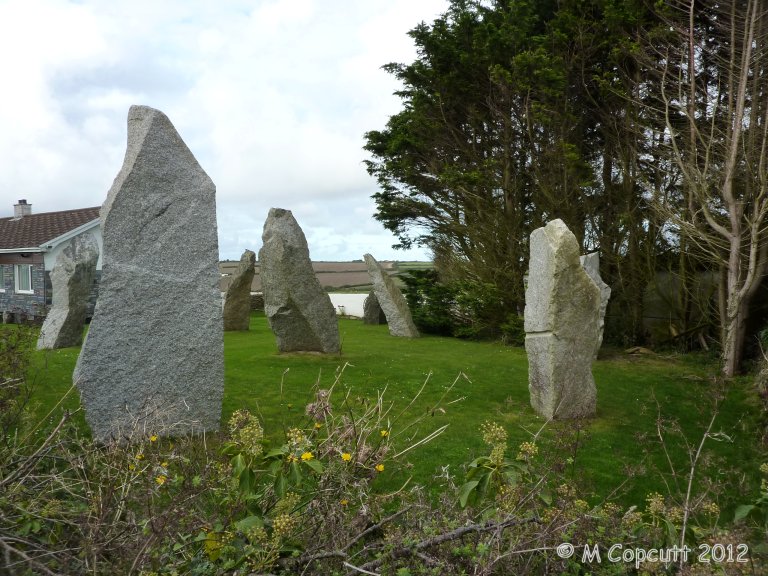
The Stones, Tresallyn Cross submitted by theCaptain on 20th Dec 2012. The stone circle at Tresallyn Cross
(View photo, vote or add a comment)
Log Text: The garden of author and artist Ed Prynn's bungalow at Tresallyn Cross, St Merryn, just a few miles from the Padstow to Wadebridge road, is a site to be seen. All sorts of megalithic monuments have been recreated here using roughly hewn modern Cornish granite. There is a stone circle, a men-an-tol, a rocking stone, a triangular Tolvan stone (the Wedding Stone) and a large Lanyon quoit style construction (the Angels Runway), and there is even a fougou constructed under the lawn. Many other stones and and artefacts are to be seen, including wishing well, maze and suchlike.
St Breock Downs Menhir
Date Added: 5th Nov 2019
Site Type: Standing Stone (Menhir)
Country: England (Cornwall)
Visited: Yes on 28th Sep 2012. My rating: Condition 3 Ambience 3 Access 4
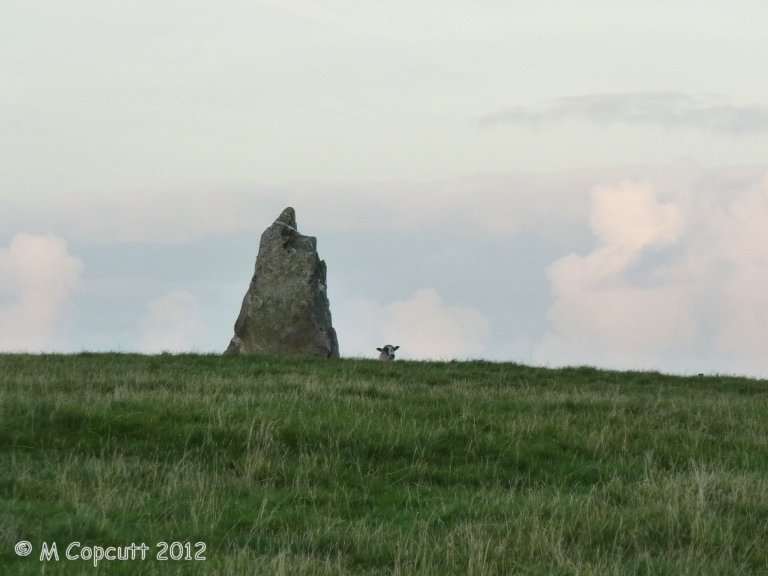
St Breock Downs Menhir submitted by theCaptain on 7th Jan 2013. Splendidly positioned and lit up when the sun goes down, but was too late with my photos.
This stone seems to have a guardian
(View photo, vote or add a comment)
Log Text: As we arrived, this ridgetop stone was lit up by the falling sun, on the top of the ridge below the wind turbines, and looked absolutely splendid. However, didn't stop, as Men Gurta and the newly refound kistvaen were more pressing in the light. Returned after visiting those, and the sun had gone down, making this stone look much less impressive. A full visit would have required crossing a fence into a field of sheep, so again I satisfied myself with taking a few photos from the edge of the field. Wish I'd spent a minute on the way up to quickly take a picture of it lit up in the sun!
St Breock Beacon Kistvaen
Date Added: 5th Nov 2019
Site Type: Burial Chamber or Dolmen
Country: England (Cornwall)
Visited: Yes on 28th Sep 2012. My rating: Condition 2 Ambience 2 Access 4

St Breock Beacon Kistvaen submitted by theCaptain on 17th Dec 2012. Recently rediscovered underneath a heavily overgrown region of scrub, just to the southwest of Men Gurta. It basically consists of two large stone slabs, one leaning on the other.
(View photo, vote or add a comment)
Log Text: Recently rediscovered underneath a heavily overgrown region of scrub, just to the southwest of Men Gurta, this monument was first recorded by William Borlase in his 1872 work Naenia Cornubiae.
It basically consists of two large stone slabs, one leaning on the other. I found it by walking in a southwesterly direction from Men Gurta across scrubland and then down a track towards the trigpoint. Just after crossing a farmtrack, there is an area of very overgrown gorse bushes, which seem to nowadays be used for dumping and tipping waste and junk. From on top of one of the piles of rubble, I had a good look around, and saw the large stones not far away, but impossible to reach from my position. Having another attempt from a more easterly position, I managed to get through the waist high gorse and brambles, while at times I found myself in water almost up to my knees! The things we stonehunters put ourselves through.
When I eventually got to the stones, I couldn't see much, as the surrounding area was so waterlogged and they are so overgrown, but it is clear they are a megalithic construction. With this now back on the megalithic map, I am sure others will be able to get better pictures and descriptions of this during better conditions, and before it becomes totally covered in the rubble and junk tipped up here.
Men Gurta
Date Added: 5th Nov 2019
Site Type: Standing Stone (Menhir)
Country: England (Cornwall)
Visited: Yes on 28th Sep 2012. My rating: Condition 4 Ambience 4 Access 4
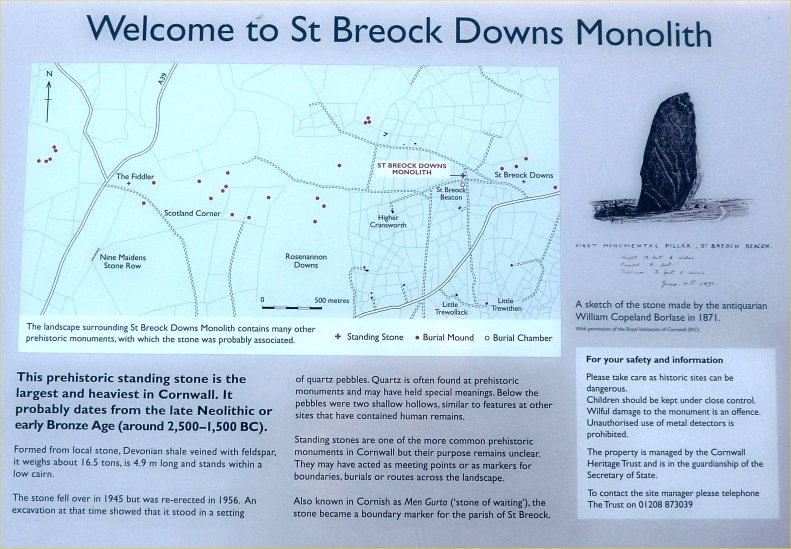
Men Gurta submitted by TheCaptain on 25th Mar 2013. There is a useful littel noticeboard up here, describing the stone and the local areas other prehistoric monuments
(View photo, vote or add a comment)
Log Text: Near the top of St Breock Down, this stone is easily reached along the little lanes to the south of Wadebridge. Men Gurta is the largest and heaviest standing stone in Cornwall. It is very nice up here in the sinking sun, with some terriffic views out to sea over the Camel estuary. I think the wind turbines add to the scene up here, other than their constant whining.
Nine Maidens Stone Row
Date Added: 5th Nov 2019
Site Type: Stone Row / Alignment
Country: England (Cornwall)
Visited: Yes on 28th Sep 2012. My rating: Condition 4 Ambience 4 Access 4
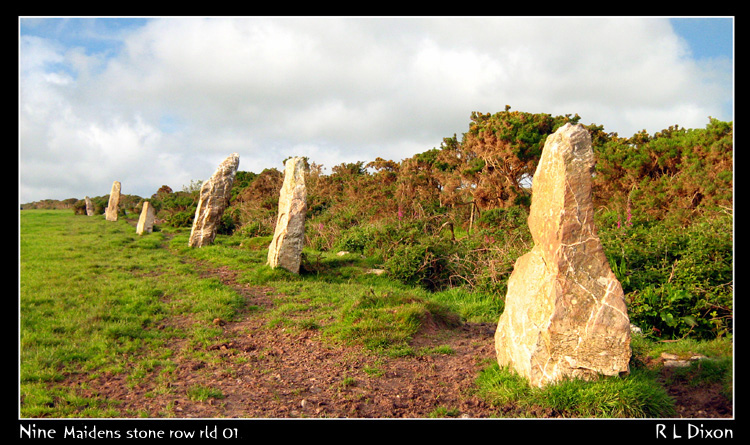
Nine Maidens Stone Row submitted by rldixon on 26th Oct 2010. Nine Maidens stone row
taken about 8pm
29-5-2008
(View photo, vote or add a comment)
Log Text: A second trip to the 9 Maidens this week, the field was still absolutely sodden, and we were over our ankles in places, which seemed strange as it is all on a reasonable slope and looked like it should drain reasonably well. At the far side of the field are the Maidens, 9 evenly spaced stones, a couple of which are now only stumps. However, the field and hedges around here are littered with large stones, and there is no doubt that there once could have been many more in this row.
The Fiddler
Date Added: 5th Nov 2019
Site Type: Standing Stone (Menhir)
Country: England (Cornwall)
Visited: Yes on 28th Sep 2012. My rating: Condition 3 Ambience 4 Access 4
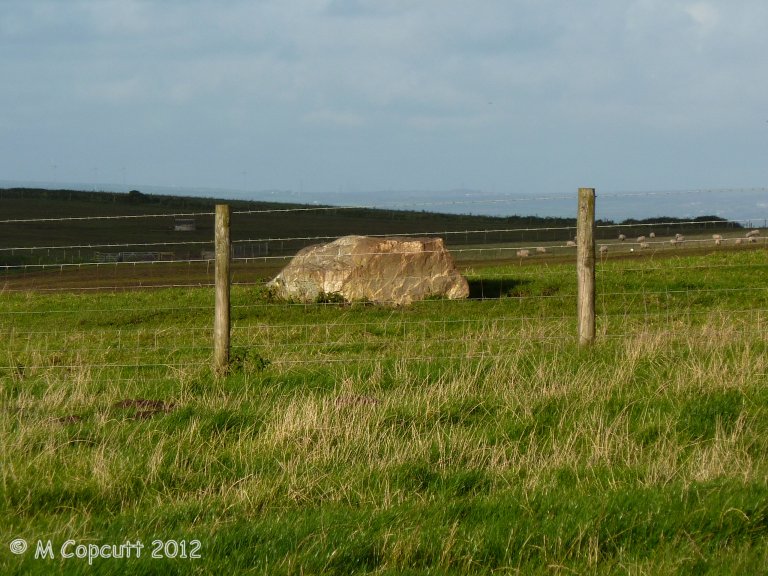
The Fiddler submitted by theCaptain on 3rd Jan 2013. Nowadays not much more than a large lump of stone laying in a field to the east of the A39 on the highpoint of land as the road passes over St Breock downs. It is positioned at a point where the line of the 9 Maidens would cross the top of the ridge.
(View photo, vote or add a comment)
Log Text: Nowadays not much more than a large lump of stone laying in a field to the east of the A39 on the highpoint of land as the road passes over St Breock downs. It is positioned at a point where the line of the 9 Maidens would cross the top of the ridge.
It is lovely light up here this afternoon, but the stone is across a fence from where I can walk to up the farm track, and the field full of livestock. It doesn't look that exciting, so I'll satisfy myself with taking pictures from the edge of the field. There is so much other large stone all around up here, that it is impossible to really tell what would be megalithic and what is field clearance.
Anta Grande do Zambujeiro
Date Added: 4th Nov 2019
Site Type: Burial Chamber or Dolmen
Country: Portugal (Évora)
Visited: Yes on 13th Oct 2019. My rating: Condition 3 Ambience 2 Access 4
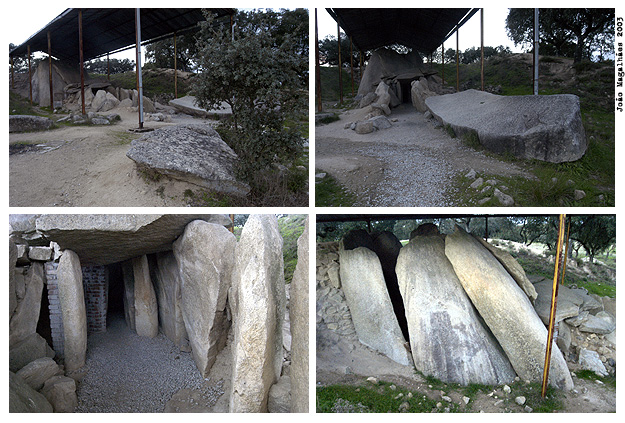
Anta Grande do Zambujeiro submitted by Magalhaes on 14th Apr 2006.
(View photo, vote or add a comment)
Log Text: With claims to being the largest burial chamber in the Iberian Peninsula, and hence one of the biggest in the world, the Anta Grande do Zambujeiro is relatively easy to find, as it is on all the megalithic circuits and leaflets, and signposted from all around. However, it is again about a kilometer along a dirt track, this one not very smooth and with some huge potholes in, so be careful. There is a nice shady place to park, with several cars in it, from where it is a couple of hundred metres walk across a footbridge and field to the fenced in site.
It is huge, but all a bit of a mess, with a big iron shed built over most of it. The entrance corridor is all falling down, and any sort of entrance to the main chamber is well blocked off. It was all obviously once buried under an enormous mound, most of which remains, but the main structure has been dug out, which is what is causing it to collapse. The main chamber, still partially enclosed, is massive and must be almost 8 metres tall, made from huge slabs. For somebody more nimble than me, it would be possible to get in through a gap in some of the side slabs, but good luck getting out again as it's 2 metres down to the floor! The capstone has been removed and lies on the ground on the slope of the mound behind the chamber. There are several other large slabs, with cupmarks and other engravings laying down outside the entrance.
Despite its massive size, and obvious importance, for me it all lacked something, perhaps because of the shed and fencing. I hope that something can be done to stabilise and repair it, and make it a much more pleasant place to visit, as obviously a lot of people do come here.
